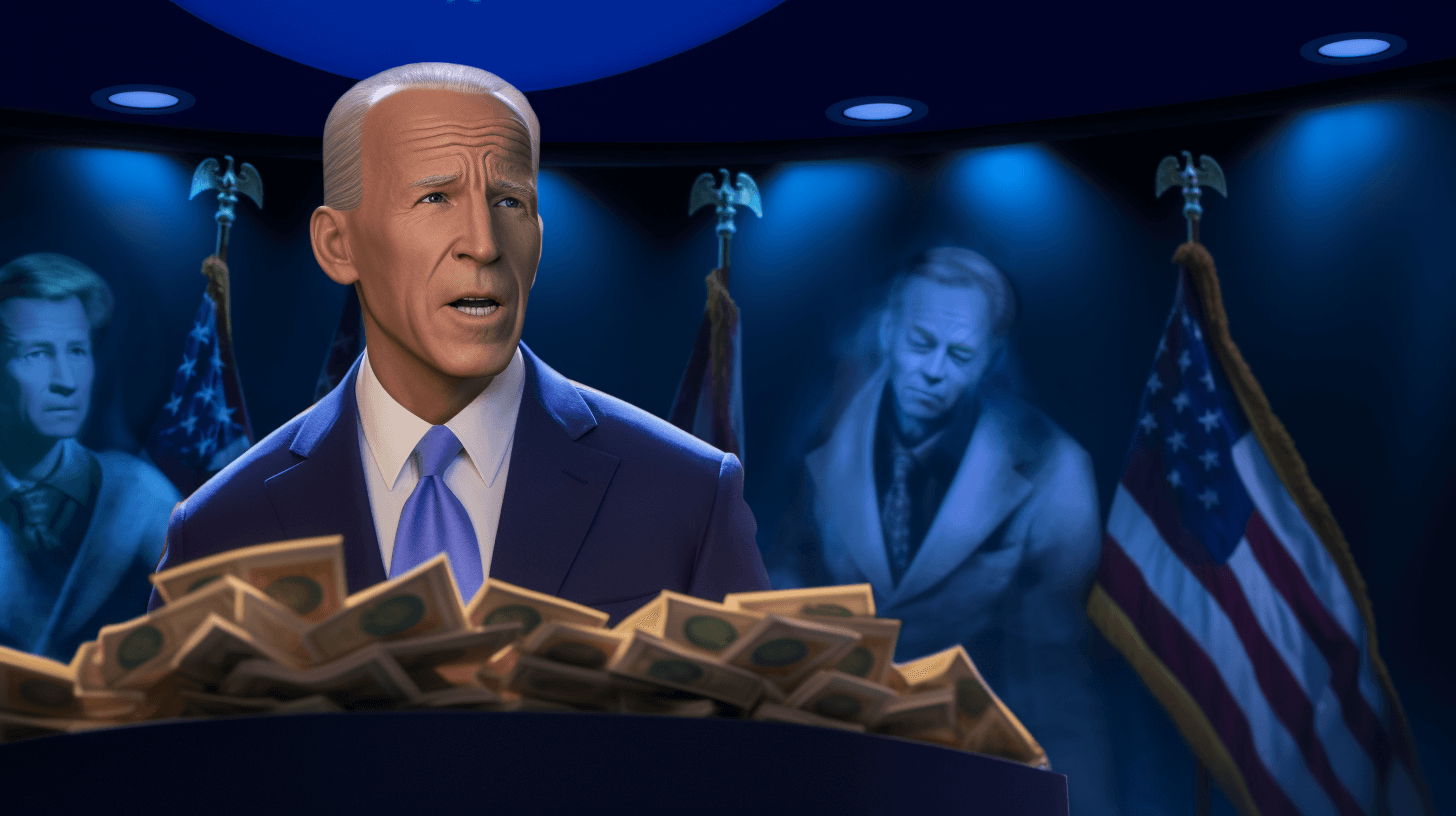📉💵🏦 Small-Kine Deal On Top Da Debt Ceiling, But No Biggie Changes To Uncle Sam’s Spending Habits
Get plenny talk story going ’round as President Biden and da House Republicans stay head to head in negotiation bout da debt limit. Stay so close to da line dat we could see one heavy kine default dat could make da nation hanabada big time. Da Republicans stay strong on their stance: dey gotta do something bout da country’s spending dat stay “no can” keep going like dis.
But check dis out, da Speaker, Kevin McCarthy, and his guys mostly been talking bout cutting one small kine part of da budget. Dey call ’em nondefense discretionary spending, dis kine stuff like money for school, protecting da ‘aina, national parks, and da guys enforcing da law here in da homeland. Dis part of da budget only make up less than 15 percent of da whopping $6.3 trillion Uncle Sam planning fo’ spend dis year. No big kine by historical standards and suppose for get small kine over da next ten years.
Da big kine things making da spending grow – like Social Security and Medicare – no even part of dis discussion. Da old folks and da sick folks depend on dese programs, and as our ohana getting more old folks, da payouts stay going up. 🏥👵👴
Da Republicans been getting hard time from Mr. Biden fo’ even thinking bout changing stuff dat could make da retirement age go up for dese programs or do other kine things for slow down da spending in da future. Dey also no like talk story about cutting da military spending, which stay almost as big as da nondefense discretionary spending. 🎖️💣💰
So, da talk story likely not gonna come out with one agreement wit Mr. Biden dat going make one big difference to da federal spending in da next ten years. Dey more likely for just make cuts to da budget for education, protecting da ‘aina, and all kine other government services. But da money guys say dis kine stuff not even da big kine sources for spending growth in da coming years. 📚🌳👮♂️
For example, if da Republicans can somehow talk Mr. Biden into agreeing with all da discretionary spending cuts in da fiscal bill da House passed last month, not gonna make big difference to da nation’s overall spending for da next ten years. Would save around $470 billion in 2033 and probably save around $100 billion dat year in borrowing costs, according to da Congressional Budget Office. 💸💡📈
After all dat, da total government spending would be just under 24 percent of da economy – pretty much same same as how it stay now. 👀💰🔄
Even though these cuts might not make big difference in da overall budget, plenty of people gonna feel ’em. Cause da cuts all stay in one part, plenty popular government programs could get small kine by as much as 30 percent, according to da calculations from da White House and independent analysts. 🏫👨👩👧👦👨🚒
Shalanda Young, da White House budget director, wen write in one memo last week, “Da cuts Republicans propose going make hard time for education, public safety, keiki care, veterans’ health care and more.” 📚👮♀️👶🏥🇺🇸
Da Republicans been talking for months dat da growing federal spending and debt is why dey no like raise da nation’s borrowing limit, risking default, unless Mr. Biden agrees to spending cuts. Representative Garret Graves of Louisiana, one of Mr. McCarthy’s top negotiators, wen say dis week dat da biggest difference with da Biden administration was on spending numbers. He said, “My interpretation of their position is dat they fail to recognize or fail to see to the fact dat we are on a spending trajectory right now dat is absolutely unsustainable.” 💰📈😨
Federal spending wen shoot up during da Covid-19 pandemic, first under President Donald J. Trump and continue under Mr. Biden, as lawmakers wen send plenty trillions of dollars in help to businesses, people, and state and local governments. Stay higher than what was normal before, when you look at ’em as a share of da economy, which is da easiest way for see how spending stay changing as prices wen go up over time. 🦠💸🏢
Da Congressional Budget Office estimates dat total spending was just under 21 percent of gross domestic product from 1980 through 2019, just before da virus hit. Jumped above 30 percent in 2020 and 2021. Dis fiscal year, suppose to be just over 24 percent, gonna go down small kine over da next several years and then start for go up again in da later years of dis decade, going over 25 percent in 2033. 💰📈📉
Discretionary spending, however, suppose to go down over da decade as a share of da economy. Military spending, which da Republicans have so far no like reduce as part of talk story with Mr. Biden’s team, should go down small kine from 3 percent of da economy. Discretionary spending outside da military now stay 3.6 percent but suppose for go down to 3.2 percent by 2033. 🎖️💰📉
On da other hand, Social Security and Medicare suppose for grow big kine over da next 10 years, as da baby boomers retiring and qualify for health and retirement benefits. Social Security spending gonna go up from 4.8 percent to 6 percent of da economy during dat time, da budget office projects, and Medicare gonna go up from 3.9 percent to 5.3 percent. 👴👵💰📈
Da guys who study dis stuff say dese programs da main reason why da budget forecasts been showing federal spending gonna increase in da coming decades, even before Mr. Biden took office.
Conservative groups been giving da Republicans hard time for not including da safety-net programs in da debt demands. Alex Durante, an economist at da Tax Foundation, which promotes lower taxes, wen write on Wednesday, “While current debt ceiling negotiations largely concern ways to restrain the discretionary parts of the budget, any serious proposal to tackle the emerging debt and deficit crisis must also address our largest mandatory spending programs: Social Security and Medicare.” 💰📉🔬
Liberal groups and da White House been giving Mr. McCarthy and his team hard time for not looking at da other side of da fiscal ledger: da nation’s tax system. Tax receipts wen go up big kine last year but suppose for go back to normal this year, stabilizing around 18 percent of da economy, da budget office projects. Mr. McCarthy been using last year’s numbers to say wrong kine dat current tax revenues stay near record highs. 📝💵🗃️
This whole mo’olelo far from pau, but stay tuned for da next chapter in dis saga, braddahs and sistahs. 📚🌈🤙🏽
NOW IN ENGLISH
📉💵🏦 Minimal Agreement on the Debt Ceiling, But No Significant Changes to Federal Spending Habits
🚀💰 As da showdown ova da debt ceiling between House Republicans and President Biden moves us dangerously close to a damaging default, da Republicans are standing firm. They insist that they gotta make some big changes to what they call da “unsustainable” spending path of da nation. 🧨💵📈
But in their discussions with Mr. Biden, Speaker Kevin McCarthy and his lieutenants have been mainly concentrating on trimming a small piece of da budget. This piece, known as nondefense discretionary spending, covers education, environmental protection, national parks, domestic law enforcement, and other areas. Dis piece only makes up less than 15 percent of da $6.3 trillion da government expects to spend dis year. It’s not a giant chunk by historical standards, and it’s even expected to get smaller as a share of da economy over da next ten years. 📚🌳👮♀️💼📉
What’s more, dis piece has nothing to do with da real big kahunas of projected spending growth in da coming years. We talking about da safety net programs Social Security and Medicare. As da American population gets older, these programs going have to shell out more and more. 👴👵💰
These programs, which are popular politically, have been put in the “no touch” zone in da current talks by da Republicans. This happened after Mr. Biden gave ’em heavy flak for even thinking about making changes that could lead to higher retirement ages for these programs or other modifications to slow their future spending. Meanwhile, da Republicans have also said no to the idea of making cuts to military spending, which is nearly as large as nondefense discretionary spending. As a result, it’s pretty much a sure thing that da negotiations are not going to come up with any agreement with Mr. Biden that would make a dramatic difference to the course of federal spending in da next decade. 🚫💵📊💣
Instead, they’d focus da budget cuts on education, environmental protection, and a bunch of other government services. Fiscal experts tell us these areas are not even close to being the main sources of spending growth in da coming years. 🏫🌲📚💵📉
For example, if da Republicans could somehow get Mr. Biden to agree to the full set of discretionary spending cuts contained in the fiscal bill da House passed last month, it wouldn’t make much difference to da nation’s overall spending path over da next decade. These cuts would only reduce federal spending by about $470 billion in 2033 and probably save about $100 billion that year in borrowing costs, according to da Congressional Budget Office. So, total government spending would then be just under 24 percent of the economy — almost exactly the same as it is now. 🧮💰📉
While these cuts might not make much of a dent in the overall budget, they’d still be felt by plenty of Americans. Because da cuts would be concentrated in one area, many popular government programs could shrink by as much as 30 percent under that scenario, as calculated by White House officials and independent analysts. 👥💔💰📉
“The cuts Republicans propose would have severe impacts on education, public safety, child care, veterans’ health care and more,” Shalanda Young, the White House budget director, wrote in a memo last week. 🏫👮♀️👶👩⚕️💵🔪
Republicans have been insisting for months now that the growing federal spending and debt is why they’vebeen refusing to raise the nation’s borrowing limit — even if that means risking a default. Their demand is that Mr. Biden agrees to spending cuts. Garret Graves of Louisiana, one of Mr. McCarthy’s top negotiators, said dis week dat da biggest difference between dem and da Biden administration officials was about da spending numbers. He said, “My interpretation of their position is that they fail to recognize or fail to see to the fact that we are on a spending trajectory right now that is absolutely unsustainable.” 🐘💰📈🤔
Federal spending went up during da Covid-19 pandemic, first under President Donald J. Trump and continued under Mr. Biden, as lawmakers approved trillions of dollars in assistance to businesses, people, and state and local governments. It still higher than historical norms, when we look at it as a share of da economy, which is da easiest way to track spending patterns as prices have gone up over time. 🏥📈💰
Da Congressional Budget Office estimates that total spending averaged just under 21 percent of gross domestic product from 1980 through 2019, just before da pandemic hit. It went up above 30 percent in 2020 and 2021. Dis fiscal year, it expected to be just over 24 percent, falling a little over da next several years and then starting to grow again in da last years of this decade, climbing past 25 percent in 2033. 📚📊💰
However, discretionary spending expected to decrease over da decade as a share of da economy. Military spending — which Republicans have up to now refused to reduce as part of talks with Mr. Biden’s team — should go down a little from 3 percent of da economy. Discretionary spending outside da military is now 3.6 percent but expected to drop to 3.2 percent by 2033. 📉💣💵
On da other hand, Social Security and Medicare are projected to grow quickly over da next 10 years, as da retiring baby boomers start receiving health and retirement benefits. Social Security spending will go up from 4.8 percent to 6 percent of da economy in dat time, according to da budget office, and Medicare will rise from 3.9 percent to 5.3 percent. 👴👵💵📈
Analysts say those programs are da main reason budget forecasts have been showing federal spending increasing in da coming decades — even before Mr. Biden took office. 📈📊💰🕰
Conservative groups have criticized Republicans for not including the safety-net programs in debt demands. Liberal groups and da White House have criticized Mr. McCarthy and his team for neglecting da other side of da fiscal ledger: da nation’s tax system. Mr. McCarthy has been using last year’s numbers to incorrectly claim current tax revenues are near record highs. 💵💸📚
In conclusion, da potential debt ceiling deal between House Republicans and President Biden is projected to have a small impact on federal spending. The negotiations are focused on areas like education and environmental protection, leaving out the main drivers of spending growth like Social Security and Medicare. As the tug of war continues, da future of federal spending remains uncertain. 🤝📈📉💰🔮







